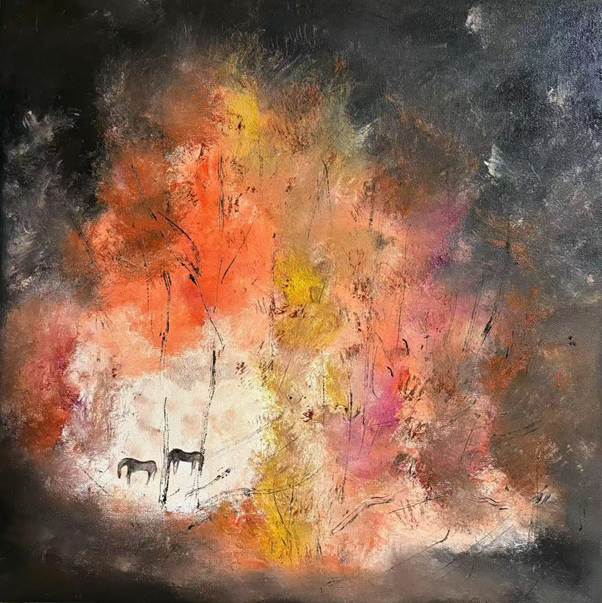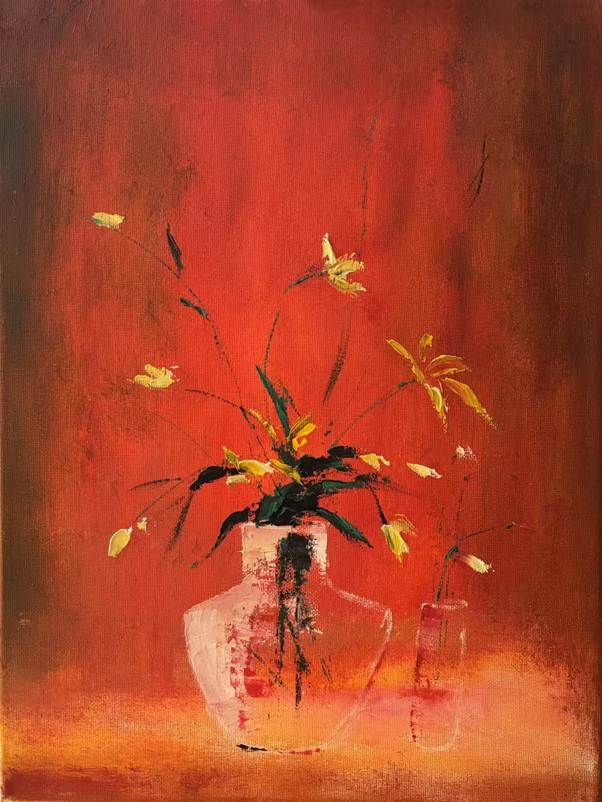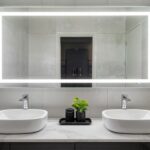Jiajing Wang is a freelance artist, a member of the MT Women Artists Empowerment (Baihui) Program, the AAlPA Abstract Artists Alliance, the AAIPA Abstract Artists Alliance, and the International Contemporary Art Committee. She graduated from Dongbei University of Finance and Economics. She worked as an IT engineer at a US-funded company before teaching herself painting and furthering her studies in an art training program at Shanghai Jiao Tong University. In 2024, she held her first solo exhibition at Shanghai M50, and her works were selected for the Xiamen International Art Fair the same year. In 2025, she was chosen for Guangdong International Art Week, and her works were shown in the “Shibaomu” International Youth Contemporary Art Exhibition, where she won the Most Popularity Award. Her works also appeared in the 4th “Trendo-Gravity Field” Phantom Tree Trend Art Exhibition.
Working primarily in abstract expressionism, Wang favors small-format linen oil paintings, using bold red–green contrasts, rugged strokes, and free compositions to seize the instantaneous tension of “nature—vitality.” Her series often draws inspiration from flowers, still lifes, and animal imagery, radically simplifying and symbolizing form to emphasize the emotional temperature of color fields and the rhythmic energy of brushwork. She frequently lays down a single-color background and then stacks highly saturated color blocks and thick knife marks locally, creating a visual field that is simultaneously loose and cohesive. She regards this “non-realist freedom” as an emotional sketch of the everyday world—color as the catalyst of emotion, brushwork as the tempo of breath—allowing the work to oscillate between warmth and mystery through improvisational layering and repeated overpainting, inviting viewers to sense the pulse of nature and life with an open mind.

Her paintings resemble an improvisational musical phrase caught between breaths: although the canvas often admits only one or two highly saturated blocks, the coarse knife scars, splashes, and repeated smears accumulate an almost drumbeat-like rhythm. She prefers to “sketch” nature on small formats such as 30×40 cm or 50×50 cm linen—petals, beasts, or branches are stripped down to symbols, leaving only chromatic pressure and stroke speed. In her still-life and floral series, she often grounds the image with a single background color, then lets red and green collide explosively, forming a color-field space that is both loose and condensed, as if compressing the flickering pulse of life into a few square inches. The blank spaces are not voids but pauses after a deep breath, allowing viewers to wander between warmth and mystery and to feel color as an emotional catalyst and the knife-edge as a metronome of breath.

She juxtaposes traditional Chinese xieyi (freehand) with Western abstract expressionism, fusing the perceptual experiences of painting, music, and dance—chromatic scales correspond to musical pitch, and the brush edge moves like choreographic steps. “What I want to capture is not the form of things, but the instant when nature roars within the body.” Hence the frequent revisions and coverings within the same format: vivid green suppressed by vermilion and then seeping out through cracks, forming a temporal record of “emotional layers.” Whether in the portrait series—half-length figures poised between image and flow—or in landscapes where just two or three lines hint at horizon and water, she insists on preserving rough edges and pigment drips, letting painting appear as an unvarnished trace of life. This “non-realist freedom” not only dissolves the object’s boundary but also pulls the viewer into an open narrative: each gaze may discover new petals, clouds, or beasts in the seams of color.
Since her first solo exhibition at Shanghai M50 in 2024, Wang’s small-format works have successively entered platforms such as the Xiamen International Art Fair and Guangdong International Art Week, and have been collected by domestic and overseas collectors. Amid the rapidly shifting contemporary art scene, she adheres to a minimal yet pulsating visual logic with humble canvas and oil paint: color precedes form, emotion precedes narrative, and vitality completes its sonata between the knife-edge and the breath.

















